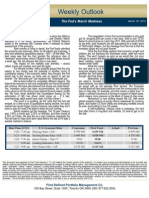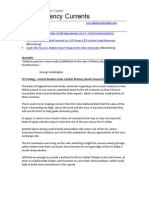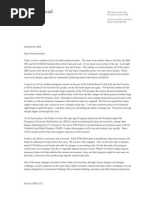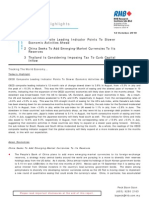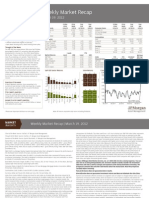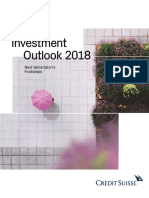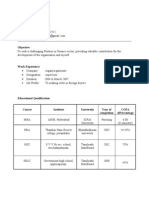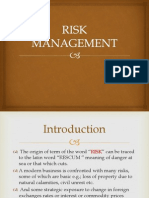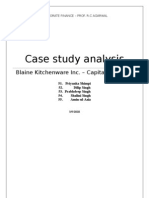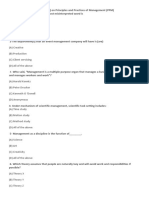Global Macro Commentary September 23
Global Macro Commentary September 23
Uploaded by
dpbasicCopyright:
Available Formats
Global Macro Commentary September 23
Global Macro Commentary September 23
Uploaded by
dpbasicOriginal Description:
Copyright
Available Formats
Share this document
Did you find this document useful?
Is this content inappropriate?
Copyright:
Available Formats
Global Macro Commentary September 23
Global Macro Commentary September 23
Uploaded by
dpbasicCopyright:
Available Formats
Global Macro Commentary
Ticking Away
Tuesday, September 23, 2014
Guy Haselmann
(212) 225-6686
Director, Capital Markets Strategy
John Zawada
Director, US Rate Sales
Ticking Away
In a switch from what are typically only one-sidedly dovish comments, NY Fed
President Dudley was balanced yesterday, even citing reasons for why the Fed would
want to hike rates.
Dudley stated that being at the zero-lower-bound is not a very comfortable place to
be, because it limits flexibility and has consequences for the economy. He said it
hurts savers, and while acknowledging what is happening to financial markets, he
avoided directly citing risks to financial stability. Anxiety-riddled conversations about
financial instability are probably implicitly restricted to a behind-closed-doors-only
rule.
FOMC members are slowly and carefully trying to change the conversation. Yellen
completely diluted away any meaning behind considerable period to make it all but
meaningless. Bullard said to that he still sees the first tightening at the end of the first
quarter.
A March 18
th
hike seems reasonable to me, since US economic improvement appears
to remain on track (at least for the moment) and since the FOMC seems more anxious
to begin the normalization process. Actually though, by waiting even until March, it
is possible that the FOMC risks missing its window of opportunity in terms of using
US economic momentum as its cover (what irony).
Financial markets are becoming agitated and disturbed by shifting government and
central bank policies, mounting geo-political tensions, and rising nationalist fervor.
QE has not yet ended and the Fed is likely still months away from hiking for the first
time, but markets are using these factors to adjust portfolio exposures. These are hints
that a larger market reaction is likely to unfold as the Feds policy transition
approaches.
Macro signs are currently evident with steep commodity price declines, rising FX
volatility, rallying global bond markets (long end), and sagging prices for low quality
credits. Some investors are clearly getting out of the Fed-generated herd trades of
recent years and saying that they are doing so because the Feds balance sheet is set to
stop expanding next month.
The strengthening dollar is one consequence and it has already had an impact on
commodities and Emerging Markets. In turn, weakening currencies in EM countries
are starting to trigger capital outflows. It may lead toward domestic central bank hikes
(again) which weaken those economies and cause second-order effects.
The prolonged period of zero rates has enabled many EM-based corporations to issue
debt in USD, so a weakening currency raises their liabilities and lowers the value of
their assets. Such a dynamic was a source of past crises.
Any anti-globalization actions, such as protectionism, will further act as global
economic headwinds. Nationalistic momentum could become disruptive via social
unrest, or via surprises in the voting booth. Extreme nationalist parties continue to gain
in popularity in numerous European countries. Religious, ethnic and tribal conflicts are
spilling across borders. Putins annexation of Crimea was a bold nationalistic action
that hid behind a veil of protecting Russian speakers. China, J apan and India all have
new nationalistic leaders who use patriotic jargon to spur structural and economic
reform.
For investors, Fed stimulus has trumped all other factors. It has lowered risk premia
and inflated asset prices. The gig is soon up, but investors have yet to adequately
adjust. Unfortunately, they will attempt to do so with significantly compromised
market liquidity. The path to normalization is made even more challenging, because
J apan and Europe are in recession, and China is slowing.
Note: Pentagon comments today about foiling an imminent attack was negative for
risk assets as are Treasury Department efforts to clampdown on inversion.
I maintain that one of the best places to hide remains in 30-year Treasury bonds.
No one told you when to run, you missed the starting gun. - Pink Floyd
FOMC Speeches
9/24 Mester 12:15 PM
9/24 Evans 1:00 PM
9/25 Lockhart 1:20 PM
9/28 Bernanke 12:15 PM
9/29 Evans 9:00 AM
Key Events
ECB OCT 2
RBA OCT 6
BoJ OCT 7
BoE OCT 9
FOMC OCT 29
www.gbm.scotiabank.com
TM
Trademark of The Bank of Nova Scotia. Used under license, where applicable. Scotiabank, together with "Global Banking and
Markets", is a marketing name for the global corporate and investment banking and capital markets businesses of The Bank of Nova
Scotia and certain of its affiliates in the countries where they operate, including Scotia Capital Inc.
Disclaimer
This publication has been prepared for Major U.S. Institutional Investors by Fixed Income Strategists of the Bank of Nova Scotia, New York
Agency. (BNS/NYA). BNS/NYA Fixed Income Strategists are employees of Scotiabanks Fixed Income Credit Sales & Trading Desk and
support the trading desk through the preparation of market commentary, including specific trading ideas, and other materials, both written and
verbal, which may or may not be made publicly available, and which may or may not be made publicly available at the same time it is made
available to the Fixed Income Credit Sales & Trading Desk. Fixed Income Strategists are not research analysts, and this report was not reviewed
by the Research Departments of Scotiabank. Fixed Income Strategist publications are not research reports and the views expressed by Fixed
Income Strategists in this and other reports may differ fromthe views expressed by other departments, including the Research Department, of
Scotiabank. The securities laws and regulations, and the policies of Scotiabank that are applicable to Research Analysts may not be applicable to
Fixed Income Strategists.
This publication is provided to you for informational purposes only. Prices shown in this publication are indicative and Scotiabank is not offering
to buy or sell, or soliciting offers to buy or sell any financial instrument. Scotiabank may engage in transactions in a manner inconsistent with the
views discussed herein. Scotiabank may have positions, or be in the process of acquiring or disposing of positions, referred to in this publication.
Other than the disclosures related to Scotiabank, the information contained in this publication has been obtained fromsources that Scotiabank
knows to be reliable, however we do not represent or warrant that such information is accurate and complete. The views expressed herein are the
views of the Fixed Income Strategists of Scotiabank and are subject to change, and Scotiabank has no obligation to update its opinions or
information in this publication. Scotiabank and any of its officers, directors and employees, including any persons involved in the preparation or
issuance of this document, may fromtime to time act as managers, co-managers or underwriters of a public offering or act as principals or agents,
deal in, own or act as market-makers or advisors, brokers or commercial and/or investment bankers in relation to the securities or related
derivatives which are the subject of this publication.
Neither Scotiabank nor any of its officers, directors, partners, or employees accepts any liability for any direct or consequential loss arising from
this publication or its contents. The securities discussed in this publication may not be suitable for all investors. Scotiabank recommends that
investors independently evaluate each issuer and security discussed in this publication, and consult with any advisors they deemnecessary prior
to making any investment.
You might also like
- Fed Up!: Success, Excess and Crisis Through the Eyes of a Hedge Fund Macro TraderFrom EverandFed Up!: Success, Excess and Crisis Through the Eyes of a Hedge Fund Macro TraderNo ratings yet
- Chris Lori - Understanding Global FundamentalsDocument38 pagesChris Lori - Understanding Global FundamentalsRui Lopes100% (1)
- Fidelity Multi-Sector Bond Fund - ENDocument3 pagesFidelity Multi-Sector Bond Fund - ENdpbasicNo ratings yet
- Global Macro Commentary Jan 5Document2 pagesGlobal Macro Commentary Jan 5dpbasicNo ratings yet
- Global Macro Commentary Feb 4Document2 pagesGlobal Macro Commentary Feb 4dpbasicNo ratings yet
- Global Macro Commentary September 4Document3 pagesGlobal Macro Commentary September 4dpbasicNo ratings yet
- Global Macro Commentary Dec 4Document3 pagesGlobal Macro Commentary Dec 4dpbasicNo ratings yet
- Global Macro Commentary Jan 13Document2 pagesGlobal Macro Commentary Jan 13dpbasicNo ratings yet
- Global Macro Commentary September 2Document2 pagesGlobal Macro Commentary September 2dpbasicNo ratings yet
- The Contra-QE Trade LoomsDocument3 pagesThe Contra-QE Trade LoomsdpbasicNo ratings yet
- Global Macro Commentary Nov 12Document2 pagesGlobal Macro Commentary Nov 12dpbasicNo ratings yet
- Global Macro Commentary Dec 19Document3 pagesGlobal Macro Commentary Dec 19dpbasicNo ratings yet
- Global Macro Commentary Jan 7Document2 pagesGlobal Macro Commentary Jan 7dpbasicNo ratings yet
- Global Macro Commentary October 9Document2 pagesGlobal Macro Commentary October 9dpbasicNo ratings yet
- Global Macro Commentary Feb 26Document2 pagesGlobal Macro Commentary Feb 26dpbasicNo ratings yet
- Global Macro Commentary February 5 - Peking Duck (For Cover)Document2 pagesGlobal Macro Commentary February 5 - Peking Duck (For Cover)dpbasicNo ratings yet
- The Monarch Report 6-18-2012Document4 pagesThe Monarch Report 6-18-2012monarchadvisorygroupNo ratings yet
- Global Macro Commentary July 21 - Too Much of EverythingDocument2 pagesGlobal Macro Commentary July 21 - Too Much of EverythingdpbasicNo ratings yet
- Federal Reserves Economic SymposiumDocument2 pagesFederal Reserves Economic SymposiumSubham MazumdarNo ratings yet
- The Feds March MadnessDocument1 pageThe Feds March Madnessrichardck61No ratings yet
- Global Macro Commentary March 20Document3 pagesGlobal Macro Commentary March 20dpbasicNo ratings yet
- Global Macro Commentary Januray 6 - Down Side Up Part DeuxDocument2 pagesGlobal Macro Commentary Januray 6 - Down Side Up Part Deuxrichardck61No ratings yet
- Degussa Marktreport Engl 22-07-2016Document11 pagesDegussa Marktreport Engl 22-07-2016richardck61No ratings yet
- Tracking The World Economy... - 23/08/2010Document3 pagesTracking The World Economy... - 23/08/2010Rhb InvestNo ratings yet
- Global Macro Commentary April 2Document3 pagesGlobal Macro Commentary April 2dpbasicNo ratings yet
- Global Macro Commentary March 12Document2 pagesGlobal Macro Commentary March 12dpbasicNo ratings yet
- SSA - STIRS Update - July 2010Document4 pagesSSA - STIRS Update - July 2010chibondkingNo ratings yet
- The Monarch Report 10/28/2013Document4 pagesThe Monarch Report 10/28/2013monarchadvisorygroupNo ratings yet
- Global Macro Commentary July 14Document2 pagesGlobal Macro Commentary July 14dpbasicNo ratings yet
- Econ - An Afternoon With Jim Rogers - 2009!02!04 Maybank-IB ETDocument3 pagesEcon - An Afternoon With Jim Rogers - 2009!02!04 Maybank-IB ETwonderwNo ratings yet
- Global Macro Commentary August 24 - Treasury Bond ShortageDocument2 pagesGlobal Macro Commentary August 24 - Treasury Bond ShortagedpbasicNo ratings yet
- Weekly Market Commentary 10/22/2012Document3 pagesWeekly Market Commentary 10/22/2012monarchadvisorygroupNo ratings yet
- CIO Note Feb 6 2018Document2 pagesCIO Note Feb 6 2018Anonymous 2LowCnVdfNo ratings yet
- Global Macro Commentary March 15 - BamboozledDocument3 pagesGlobal Macro Commentary March 15 - Bamboozledrichardck61No ratings yet
- Thursday 1 October 2009Document6 pagesThursday 1 October 2009ZerohedgeNo ratings yet
- The Weekly Market Update For The Week of October 13, 2014.Document2 pagesThe Weekly Market Update For The Week of October 13, 2014.mike1473No ratings yet
- QBAMCO - Locked & LoadedDocument16 pagesQBAMCO - Locked & LoadedZerohedgeNo ratings yet
- Weekly Market Commentary 6-24-13Document3 pagesWeekly Market Commentary 6-24-13Stephen GierlNo ratings yet
- 0255 PDFDocument68 pages0255 PDFNDNo ratings yet
- Signs of Risk Aversion ReturnsDocument5 pagesSigns of Risk Aversion ReturnsValuEngine.comNo ratings yet
- Weekly Market Commentary 5/28/2013Document2 pagesWeekly Market Commentary 5/28/2013monarchadvisorygroupNo ratings yet
- Compass Financial - Lincoln Anderson Commentary Oct 6 2008Document3 pagesCompass Financial - Lincoln Anderson Commentary Oct 6 2008compassfinancialNo ratings yet
- Strategy DailyDocument3 pagesStrategy DailySr. BentesNo ratings yet
- Economist Insights 20120416Document2 pagesEconomist Insights 20120416buyanalystlondonNo ratings yet
- Third Quarter 2016 Investment Outlook: Asset Class SectorDocument6 pagesThird Quarter 2016 Investment Outlook: Asset Class SectorAnonymous DJrec2No ratings yet
- September CommentaryDocument2 pagesSeptember Commentaryapi-291251278No ratings yet
- Tracking The World Economy... - 12/10/2010Document2 pagesTracking The World Economy... - 12/10/2010Rhb InvestNo ratings yet
- The World Economy... - 19/7/2010Document2 pagesThe World Economy... - 19/7/2010Rhb InvestNo ratings yet
- The FED ApathyDocument3 pagesThe FED ApathySubham MazumdarNo ratings yet
- FOREX - Fundamentals Article 2007 01Document3 pagesFOREX - Fundamentals Article 2007 01jetim020No ratings yet
- Financial Times 2015-02-11 Analysis. Currencies Cold Front Blows in For EM Carry Trade, p24Document3 pagesFinancial Times 2015-02-11 Analysis. Currencies Cold Front Blows in For EM Carry Trade, p24luckyboy77No ratings yet
- Global Macro Commentary August 19 - Raging (Bond) BullDocument3 pagesGlobal Macro Commentary August 19 - Raging (Bond) BulldpbasicNo ratings yet
- SE-Banken, Investment Outlook, Dec 2013, "Market Hopes Will Require Some Evidence"Document35 pagesSE-Banken, Investment Outlook, Dec 2013, "Market Hopes Will Require Some Evidence"Glenn ViklundNo ratings yet
- WPDocument DisplayDocument2 pagesWPDocument Displaytanner7552No ratings yet
- Market Insight - The Unbearable Lightness of Money 12-14-12-1Document2 pagesMarket Insight - The Unbearable Lightness of Money 12-14-12-1pgrat10No ratings yet
- 'Nowhere To Hide?' How Stagflation Fears Put Stocks On Verge of A Bear Market - MarketWatchDocument5 pages'Nowhere To Hide?' How Stagflation Fears Put Stocks On Verge of A Bear Market - MarketWatchSunny YaoNo ratings yet
- JPM Weekly MKT Recap 3-19-12Document2 pagesJPM Weekly MKT Recap 3-19-12Flat Fee PortfoliosNo ratings yet
- The World Economy... - 06/04/2010Document2 pagesThe World Economy... - 06/04/2010Rhb InvestNo ratings yet
- Interest Rate & Economic Policy Analysis for Traders and Investors: Fundamental AnalysisFrom EverandInterest Rate & Economic Policy Analysis for Traders and Investors: Fundamental AnalysisNo ratings yet
- Rational Market Economics: A Compass for the Beginning InvestorFrom EverandRational Market Economics: A Compass for the Beginning InvestorNo ratings yet
- The Future of Finance: A New Model for Banking and InvestmentFrom EverandThe Future of Finance: A New Model for Banking and InvestmentNo ratings yet
- BMO ETF Portfolio Strategy Report: Playing Smart DefenseDocument7 pagesBMO ETF Portfolio Strategy Report: Playing Smart DefensedpbasicNo ratings yet
- Credit Suisse Investment Outlook 2018Document64 pagesCredit Suisse Investment Outlook 2018dpbasic100% (1)
- GMOMelt UpDocument13 pagesGMOMelt UpHeisenberg100% (2)
- Thackray Seasonal Report Storm Warning 2017-May-05Document12 pagesThackray Seasonal Report Storm Warning 2017-May-05dpbasic100% (1)
- Hot Charts 9feb2017Document2 pagesHot Charts 9feb2017dpbasicNo ratings yet
- Retirement 20/20: The Right Advice Can Bring Your Future Into FocusDocument12 pagesRetirement 20/20: The Right Advice Can Bring Your Future Into FocusdpbasicNo ratings yet
- From Low Volatility To High GrowthDocument4 pagesFrom Low Volatility To High GrowthdpbasicNo ratings yet
- Thackray Newsletter: - Know Your Buy & Sells A Month in AdvanceDocument11 pagesThackray Newsletter: - Know Your Buy & Sells A Month in AdvancedpbasicNo ratings yet
- Hot Charts 17nov2016Document2 pagesHot Charts 17nov2016dpbasicNo ratings yet
- INM 21993e DWolf Q4 2016 NewEra Retail SecuredDocument4 pagesINM 21993e DWolf Q4 2016 NewEra Retail SecureddpbasicNo ratings yet
- CMX Roadshow Final Oct 27 2016Document25 pagesCMX Roadshow Final Oct 27 2016dpbasicNo ratings yet
- Peloton Webinar September 26-2016Document26 pagesPeloton Webinar September 26-2016dpbasicNo ratings yet
- Thackray Newsletter: - Know Your Buy & Sells A Month in AdvanceDocument11 pagesThackray Newsletter: - Know Your Buy & Sells A Month in AdvancedpbasicNo ratings yet
- Next Edge Private Lending Presentation v1Document16 pagesNext Edge Private Lending Presentation v1dpbasicNo ratings yet
- Advantagewon Presentation Oct 2016 Draft 1Document16 pagesAdvantagewon Presentation Oct 2016 Draft 1dpbasicNo ratings yet
- Thackray Newsletter 2016 09 SeptemberDocument9 pagesThackray Newsletter 2016 09 SeptemberdpbasicNo ratings yet
- An Investment Only A Mother Could Love The Case For Natural Resource EquitiesDocument12 pagesAn Investment Only A Mother Could Love The Case For Natural Resource EquitiessuperinvestorbulletiNo ratings yet
- Merchant BankingDocument25 pagesMerchant Bankingsshishirkumar50% (2)
- Year Book 2009-10 PDFDocument168 pagesYear Book 2009-10 PDFMahmood KhanNo ratings yet
- Okta Economic Impact 3.6Document22 pagesOkta Economic Impact 3.6mathurashwaniNo ratings yet
- Sources of Finance For Startups and SMEsDocument4 pagesSources of Finance For Startups and SMEsTawanda Percy MutsandoNo ratings yet
- Pak-Kuwait Investment Company PVT LTDDocument30 pagesPak-Kuwait Investment Company PVT LTDSohailNo ratings yet
- Allotment of SharesDocument17 pagesAllotment of SharesHimanshu Premani100% (1)
- NBFC ChecklistDocument23 pagesNBFC ChecklistSanjeev MaharNo ratings yet
- G3.1 Content Index: Application LevelDocument120 pagesG3.1 Content Index: Application Leveljucia wantaNo ratings yet
- "We Like": Rohit Kiran KeluskarDocument43 pages"We Like": Rohit Kiran Keluskarrohit keluskarNo ratings yet
- P14 SFM (2nd Paper)Document9 pagesP14 SFM (2nd Paper)Shivam GuptaNo ratings yet
- CW HWDocument8 pagesCW HWRupok AnandaNo ratings yet
- R.senthil KumarDocument4 pagesR.senthil Kumar9030841912No ratings yet
- Running Head: Assessing A Company'S Future Financial Health 1Document5 pagesRunning Head: Assessing A Company'S Future Financial Health 1DonaldNo ratings yet
- Module@1 2Document11 pagesModule@1 2mohammedarshad0021No ratings yet
- Jabil Circuit Vertical Analysis (6050)Document12 pagesJabil Circuit Vertical Analysis (6050)Roy OmabuwaNo ratings yet
- Risk Management For MBA StudentsDocument28 pagesRisk Management For MBA StudentsMuneeb Sada50% (2)
- Paper 307 A - International Financial ManagementDocument103 pagesPaper 307 A - International Financial ManagementSwapnil SonjeNo ratings yet
- Answer The Following QuestionsDocument23 pagesAnswer The Following QuestionsnirajdjainNo ratings yet
- Blaine Kitchenware Inc.Document13 pagesBlaine Kitchenware Inc.vishitj100% (4)
- Weighted Average CostDocument5 pagesWeighted Average CostsureshdassNo ratings yet
- 1 s2.0 S154461232300569X MainDocument6 pages1 s2.0 S154461232300569X Mainsonia969696No ratings yet
- MCQs of ManagementDocument16 pagesMCQs of Managementahsee khan33% (3)
- FinmanDocument1 pageFinmanRegine ConsueloNo ratings yet
- Indonesia Strategy: ALERT: Omnibus Bill For Job Creation Finally Passed Into LawDocument7 pagesIndonesia Strategy: ALERT: Omnibus Bill For Job Creation Finally Passed Into LawIxzy QuinnNo ratings yet
- Due Diligence - One PagerDocument2 pagesDue Diligence - One PagerRaghulNo ratings yet
- Advanced Accounting 1: Chapter 3 - Dissolution, Problem 5Document3 pagesAdvanced Accounting 1: Chapter 3 - Dissolution, Problem 5isay floresNo ratings yet
- PrinciplesofMarketing 01 WhatisMarketingDocument25 pagesPrinciplesofMarketing 01 WhatisMarketingmamaNo ratings yet
- Chapter 6 AnnuityDocument62 pagesChapter 6 Annuity2022885126No ratings yet
- NCBA-Quiz LAWDocument2 pagesNCBA-Quiz LAWRONZALES, Genie RoseNo ratings yet
- GCC Rea Estate UpdateDocument9 pagesGCC Rea Estate UpdateKalid JmalNo ratings yet



















